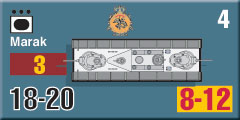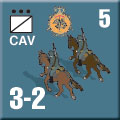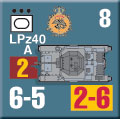| Land Cruisers:
Scenario Preview, Part Three
By Mike Bennighof, Ph.D.
October 2020
 If you’re going to publish an alternative history game, and you want people to like it, then it needs to be weird, wonderful and fun. The same sort of game, with a different back story and different-colored pieces, just won’t do. If you’re going to publish an alternative history game, and you want people to like it, then it needs to be weird, wonderful and fun. The same sort of game, with a different back story and different-colored pieces, just won’t do.
Panzer Grenadier: Land Cruisers meets the standards for weirdness, wonderfulness and fun. In this story, the Imperial German Army (which still exists in the 1940 of this reality) has drawn on a generations-long tradition of over-engineering its problems to create massive mobile steel fortresses known as Land Cruisers. When the fascist French launch a dastardly sneak attack, their armored columns punch their way through Germany’s frontier fortifications and seem unstoppable until they meet Germany’s secret weapon, the gigantic Land Cruisers.
In the first two installments of this mini-series of scenario previews, we looked at the preliminaries. Now it’s time for the main event, when the Land Cruisers enter combat in mass. Let’s have a look.
Scenario Seven
Clash of Armor
24 September 1940
 Prince Franz directed that all eight Land Cruisers of the 1st Mechanized Support Brigade attack the oncoming French on a narrow front. The French cooperated by charging forward almost directly toward the brigade’s assembly area, solving the slow-moving machines’ enormous deployment problem. At brigade headquarters a General Staff liaison officer filed reports on the attack’s progress every fifteen minutes, with his missives going not only directly to Field Marshal Lettow but to the Kaiser himself. Wilhelm expected great things from the mighty machines; his top general, having seen them himself, had deeper reservations. Prince Franz directed that all eight Land Cruisers of the 1st Mechanized Support Brigade attack the oncoming French on a narrow front. The French cooperated by charging forward almost directly toward the brigade’s assembly area, solving the slow-moving machines’ enormous deployment problem. At brigade headquarters a General Staff liaison officer filed reports on the attack’s progress every fifteen minutes, with his missives going not only directly to Field Marshal Lettow but to the Kaiser himself. Wilhelm expected great things from the mighty machines; his top general, having seen them himself, had deeper reservations.
Carrying the Supreme War Lord’s hopes and the commander-in-chief’s cynical blessing, the huge vehicles lumbered out into the early morning haze ready for battle.
Conclusion
The Land Cruisers’ low speed put them at a disadvantage against the French Somua tanks, but the small infantry-support Renaults were only slightly faster and utterly defenseless against the big high-velocity guns of the Germans. French attempts to close and assault the huge beasts were driven off by the German infantry riding inside the Land Cruisers for just such an eventuality, while the Imperial German Luftstreitkräfte for once managed to keep French close air support at bay.
Halder’s assessment of the action, however, indicated that the Land Cruisers performed best when the French could be forced to attack them. As offensive weapons, the Land Cruisers had several drawbacks. They were slow, and although powerful, could not take and hold ground, nor could they even enter certain types of terrain such as ridges or towns that were critical objectives. Some of the American observers had dubbed the Land Cruisers “LSTs” for large, slow, target. The heavy losses experienced by the French indicated that, despite their failings, the Land Cruisers were anything but LSTs.
Notes
All eight Land Cruisers are in action at once, fending off a mass of French armor. The big Land Cruisers can smash the smaller French tanks pretty easily, and the bigger ones without that much more trouble. The French will have to swarm over them if they wish to meet their objectives.
Scenario Eight
Turning the Tables
2 October 1940
 With the French offensive temporarily blunted in his sector, Prince Franz decided to take advantage of the success and drive back the invaders while they retained their fear of the huge vehicles. The monstrosities had been very effective in a defensive role but the Imperial Army had to find some means of using them on the offensive if they were to roll back the French from German soil. With the French offensive temporarily blunted in his sector, Prince Franz decided to take advantage of the success and drive back the invaders while they retained their fear of the huge vehicles. The monstrosities had been very effective in a defensive role but the Imperial Army had to find some means of using them on the offensive if they were to roll back the French from German soil.
Rather than try to move the ponderous machines, Prince Franz again turned to Halder to find a spot to use the less powerful Land Cruisers to good effect. After some repairs to breakdowns and minor battle damage, the 1st Mechanized Support Brigade’s 1st Battalion waddled into action to support an attacking Hessian infantry division.
Conclusion
The Land Cruisers’ firepower inflicted heavy losses on the French, with their heavy guns often firing at French positions over open sights, but the attack lacked the infantry support it needed to secure the enemy positions. The Land Cruisers moved to point-blank range and reduced the built-up areas to fine powder, but it would require more infantry to take and hold the vacated ground. Prince Franz ordered Halder to try again with all eight Land Cruisers before the French could reinforce their lines or devise some sort of counter-measures against the huge vehicles.
Notes
The Land Cruisers are on the attack! The four “weaker” ones (this being relative – they’re still pretty powerful) are trying to take French-held ground and flatten French units. They have some trouble with the former, but are very good at the latter.
Scenario Nine
Renewed Attack
5 October 1940
 With all eight Land Cruisers now repaired and ready for action, the Germans renewed their attack on the French 26th Infantry Division on the following morning. Halder and the 1st Mechanized Support Brigade’s commander, Adelbert Schulz, shared a concern over a shortage of supporting infantry but hoped that massed firepower would make up for that lack. The French still had no answer for the giant machines, but no longer panicked at the sight of them. The Land Cruisers had been designed to break through entrenched enemy positions, not to fight enemy tanks, and now they could prove their worth. With all eight Land Cruisers now repaired and ready for action, the Germans renewed their attack on the French 26th Infantry Division on the following morning. Halder and the 1st Mechanized Support Brigade’s commander, Adelbert Schulz, shared a concern over a shortage of supporting infantry but hoped that massed firepower would make up for that lack. The French still had no answer for the giant machines, but no longer panicked at the sight of them. The Land Cruisers had been designed to break through entrenched enemy positions, not to fight enemy tanks, and now they could prove their worth.
Conclusion
Massive firepower concentrated in a small area made a difference. Despite fierce French resistance, the Land Cruisers smashed through the French line and rolled up its open flanks, inflicting massive losses on the infantry and smashing flat several artillery batteries. It was one of the very few positive outcomes in a very bleak situation for Imperial Germany, as the Kaiser weighed the moral question of using poison gas to stop the invasion.
Notes
The Land Cruisers are back on the attack, this time with all eight of them in action. This is what wargaming is all about.
Scenario Ten
Apocalyptic Clash
9 October 1940
 Prince Franz ordered the Upper Rhine Army Group’s last fresh reserves into the breach opened by the Land Cruisers: a tank brigade and an independent regiment of parade-ground horsed cavalry. Only in this sector had the Germans seen much defensive success; the French now approached the Rhine River and the Imperial Army did not wish to yield the Left Bank to the enemy. All weapons would be used to defend Germany, and that included the Land Cruisers. Prince Franz ordered the Upper Rhine Army Group’s last fresh reserves into the breach opened by the Land Cruisers: a tank brigade and an independent regiment of parade-ground horsed cavalry. Only in this sector had the Germans seen much defensive success; the French now approached the Rhine River and the Imperial Army did not wish to yield the Left Bank to the enemy. All weapons would be used to defend Germany, and that included the Land Cruisers.
Halder’s work on the correct deployment of the Land Cruisers had been masterful but if the French were to be denied the Rhine the Imperial Army would have to use them as offensive weapons and coordinate them with tanks and horsed cavalry. Pre-war secrecy had prevented any exercises between the branches, and the brigade’s planners had not developed any doctrine for such combined arms operations, having only foreseen cooperation with infantry and artillery. At least the frontage was reasonably short.
Conclusion
The French finally managed to disable several of the Land Cruisers and damage the others through a combination of tank attacks, air strikes and reckless infantry close assaults. But their “victory” came at enormous cost, with incredible losses in tanks and first-line infantry that could not be quickly replaced. The Land Cruisers had given Prince Franz and General Halder the breathing space they wanted to organize their defenses; whether they could make use of it remained to be seen.
Notes
It’s the grand final battle, with all of the Germans on the board against wave upon wave of French tanks and infantry. The Land Cruisers are powerful, but can they withstand this many enemies?
And that’s the story of Land Cruisers. Pick it up and write your own fake history.
Click right here to order Land Cruisers right now.
Sign up for our newsletter right here. Your info will never be sold or transferred; we'll just use it to update you on new games and new offers.
Mike Bennighof is president of Avalanche Press and holds a doctorate in history from Emory University. A Fulbright Scholar and NASA Journalist in Space finalist, he has published countless books, games and articles on historical subjects; some of them are actually good.
He lives in Birmingham, Alabama with his wife, three children and his dog, Leopold.
Want to keep Daily Content free of third-party ads? You can send us some love (and cash) through this link right here. You don’t have to, but Leopold would like it if you did.
|
